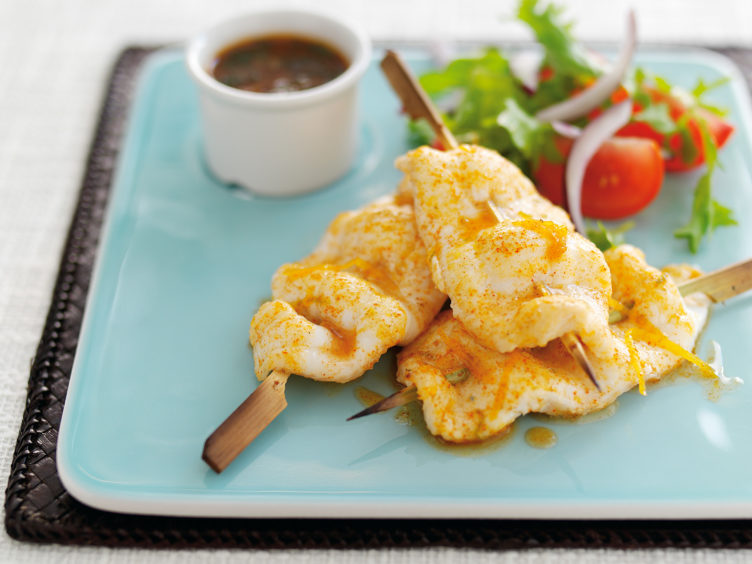
Sizzling sausages, juicy burgers and skewered veggies charred over hot coals – just the sight, sound and smell of a back garden barbecue tells us summer has arrived.
But, according to chef and world barbecue champion, Ben Bartlett, stocking up for an al fresco cookout shouldn’t start and end at the butchers.
Swapping the usual bangers and burgers for mackerel, hake, lemon sole, and even more adventurous options like mussels, is a surefire way to wow friends and family during your next barbecue, and Ben says cooking with fresh fish couldn’t be easier.
“People often ask me, ‘What’s your favourite thing to cook on the barbecue?’ and I always say ‘Fish’,” explained Ben, ambassador for the Sea for Yourself campaign run by Seafish.
“There are so many varieties and types of fish and shellfish, and you can cook them so many different ways, especially on a barbecue. It doesn’t matter if it’s gas or charcoal – they’re both fires – and you just need two or three ingredients to create a great dish.”
In the kitchen, whipping up a delicious restaurant-worthy meal would usually require multiple steps, complicated instructions and lots of unusual ingredients. But Ben admits the key to cooking amazing barbecued fish is keeping it simple, adding just a few seasonings and focusing on the seafood’s natural flavour.
He said: “The simplest seasoning for seafood is salt and pepper. But you can take this up a level with a squeeze of lemon, which can add moisture and a really zingy, fresh flavour. To spice things up, try adding some olive oil with chilli and garlic or paprika and lemon zest.
“Fish cooked in any way on the barbecue will always taste amazing, but my go-to methods are either wrapping the fish in foil or simply grilled straight on the barbecue.
“When cooking fish wrapped in foil, herbs and spices come into their own, and the fish comes out very moist – the meat just flakes off the bones. If you cook directly on the grill, my top tip is to season the flesh with olive oil and rosemary before you start. Not only does this add great flavour, it stops the fish from sticking to your barbecue.”
And if you’re looking to add the wow factor to your next flame-grilled feast, Ben advises discovering the power, aroma and flavour that comes with cooking with different types of wood, which barbecue aficionados call “planking”.
He explained: “Wood really does add a bit of extra flavour, especially when cooking with fish.
“You can use either thick or very thin, slightly thicker than paper, sheets in a range of flavours.
“To begin, soak the wood sheets in water or apple juice or whiskey, then simply put your fish on top – this method slowly cooks the fish, and the wood gives it a lovely smokiness. I like fruit woods, such as apple and cherry, or you could opt for really smoky woods like mesquite and hickory. Oak is also a good all-purpose choice.”
As soon as the clouds part and the sun makes an appearance, many people pop down to their local supermarket or petrol station to grab an affordable, disposable barbecue. But Ben warns against using throw-away trays, and recommends investing in good quality kit you can use time and time again.
He said: “Don’t buy those cheap, throw-away barbecues from the petrol station. They come with briquettes, which are coated in a petroleum-based substance that taints the food and they don’t give out heat for long enough to actually cook. So, you can run the risk of food poisoning.
“Gas is a good choice for a family barbecue, but if you are going for charcoal, I always recommend good British, lumpwood charcoal. You can use an ethanol firelighter to set your barbecue, which are good for the environment, and there’s lots of good ones to choose from now.”
Visit fishisthedish.co.uk
Recipe: Citrus lemon sole skewers

You’ll need
- 4 x 170g lemon sole fillets, skinned
- Salad, to serve
- 8 tbsp spicy tomato sauce, to serve
- 8 wooden skewers, soaked in cold water for 30 minutes
For the marinade:
- Juice and zest 1 lemon
- Juice and zest 2 limes
- 1 tbsp clear honey
- 1 tbsp olive oil
- 1 tsp ground coriander
- 1 tsp paprika
- 1 tsp ground cumin
- 1 tbsp chopped fresh mint
Method
Mix all of the marinade ingredients together and place in a shallow, non-metallic dish.
Halve each lemon sole fillet lengthways and thread on to the skewers.
Place the skewers in the marinade and turn until covered. Cover and leave to marinate for up to 15 minutes.
Preheat the barbecue or grill.
Cook the skewers on the barbecue or under the grill for about 6 minutes, turning occasionally. Serve with the salad and tomato sauce.
Ben’s top tips
Wear disposable gloves when cooking to avoid cross contamination, and make sure to use separate tongs and utensils for raw and cooked meat and fish.
Invest in a digital thermometer to check the core temperature of your meat and fish, ensuring everything is fully cooked and safe to eat. The recommended safe temperature is 85 degrees.
Remember, fish carries on cooking for up to a minute after you take it off the heat, so bear this in mind to avoid dishing up a dry fillet.
Fill a hand sprayer – like one you would use to mist house plants – with unsweetened apple juice, and spray it on anything you’re cooking on the barbecue. It’s particularly good for fish, as it keeps the flesh moist and adds a lovely caramelisation, but you can use it on meat and veg, too.

Enjoy the convenience of having The Sunday Post delivered as a digital ePaper straight to your smartphone, tablet or computer.
Subscribe for only £5.49 a month and enjoy all the benefits of the printed paper as a digital replica.
Subscribe